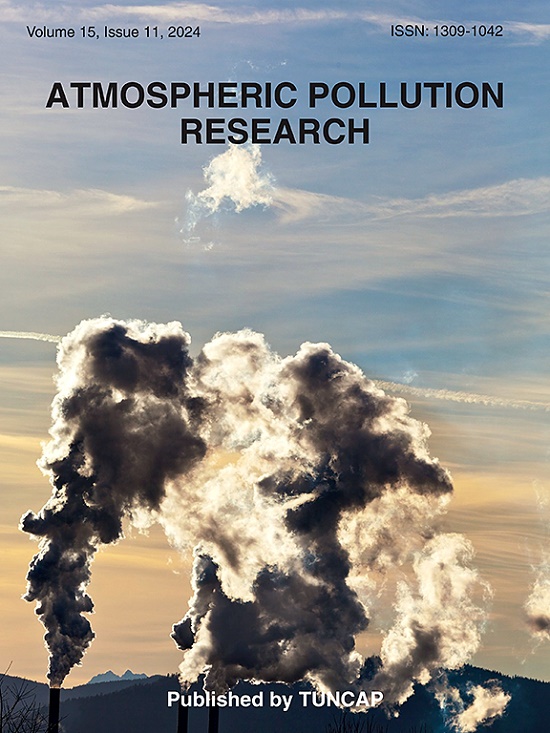土壤排放的HONO和其他含氮气体:对微生物途径和水分影响的见解
IF 3.5
3区 环境科学与生态学
Q2 ENVIRONMENTAL SCIENCES
引用次数: 0
摘要
亚硝酸(HONO)通过光解作用产生羟基自由基(OH),极大地影响了对流层化学,但我们对HONO的来源仍然知之甚少。土壤中含氮气体的排放一直是生物地球化学研究的一个课题。土壤排放的HONO最近受到了更多的关注,这有助于解释观测到的大气HONO的缺失来源。通过室内实验,同时测量红土样品中HONO与其他含氮气体(包括一氧化氮(NO)、氧化亚氮(N2O)和氨(NH3))的排放通量,并通过过程抑制实验评估微生物过程对HONO排放的贡献。监控排放的结果在一个完整的wet-drying周期表明,HONO的排放,没有和一氧化二氮强烈依赖土壤含水量与最大通量HONO(125±17 ng N m 2 s−−1),没有(115±11 ng N m 2 s−−1)和一氧化二氮(453±100 ng N m 2 s−−1)观察到17% (HONO), 42% (NO)和94%(一氧化二氮)水填充孔隙空间(粮食计划署),分别虽然NH3排放仍在16∼ng N m 2 s−−1多数wfp范围。过程抑制实验结果表明,在低含水量范围内,氨氧化是HONO生成的主要途径,而在高含水量范围内,硝酸盐还原为NO2−则是主要途径。我们的研究表明,将HONO和其他含氮气体的排放作为一个整体过程的连接网络进行研究是可行的。本文章由计算机程序翻译,如有差异,请以英文原文为准。

Soil emissions of HONO and other nitrogen-containing gases: Insights into microbial pathways and moisture effects
Nitrous acid (HONO) greatly impacts tropospheric chemistry by producing hydroxyl radical (OH) through photolysis, and yet our knowledge about sources of HONO remains elusive. Emissions of nitrogen (N) containing gases from soils have long been a subject of research in biogeochemistry. Soil emissions of HONO have received greater attention recently, helping explain a missing source of observed atmospheric HONO. We conducted laboratory experiments to simultaneously measure emission fluxes of HONO along with other N containing gases including nitric oxide (NO), nitrous oxide (N2O), and ammonia (NH3) from lateritic red soil samples, and evaluated the contributions of microbiological processes to HONO emissions by conducting process inhibiting experiments. Results from monitoring emissions during a full wet-drying cycle showed that the emissions of HONO, NO and N2O have a strong dependance on soil water content, with maximum fluxes for HONO (125 ± 17 ng N m−2 s−1), NO (115 ± 11 ng N m−2 s−1) and N2O (453 ± 100 ng N m−2 s−1) observed at 17 % (HONO), 42 % (NO) and 94 % (N2O) water filled pore space (WFPS), respectively, while NH3 emission remains at ∼16 ng N m−2 s−1 in majority of the WFPS range. Results from process inhibiting experiments suggested ammonia oxidation to be the dominant pathway for HONO production in the low water-content range, while reduction of nitrate to NO2− appeared dominant in the high water-content range. Our study demonstrates the feasibility of studying emissions of HONO along with other N containing gases as connected network of processes as a whole.
求助全文
通过发布文献求助,成功后即可免费获取论文全文。
去求助
来源期刊

Atmospheric Pollution Research
ENVIRONMENTAL SCIENCES-
CiteScore
8.30
自引率
6.70%
发文量
256
审稿时长
36 days
期刊介绍:
Atmospheric Pollution Research (APR) is an international journal designed for the publication of articles on air pollution. Papers should present novel experimental results, theory and modeling of air pollution on local, regional, or global scales. Areas covered are research on inorganic, organic, and persistent organic air pollutants, air quality monitoring, air quality management, atmospheric dispersion and transport, air-surface (soil, water, and vegetation) exchange of pollutants, dry and wet deposition, indoor air quality, exposure assessment, health effects, satellite measurements, natural emissions, atmospheric chemistry, greenhouse gases, and effects on climate change.
 求助内容:
求助内容: 应助结果提醒方式:
应助结果提醒方式:


